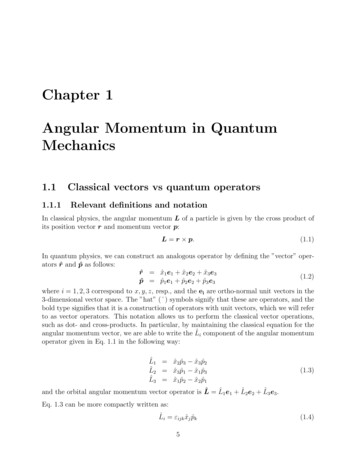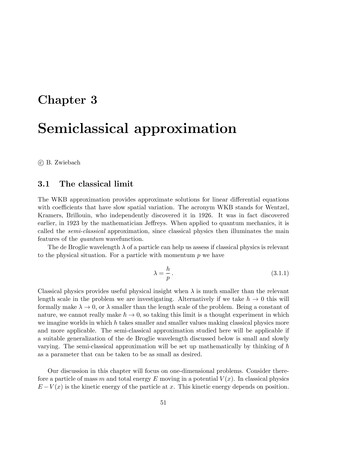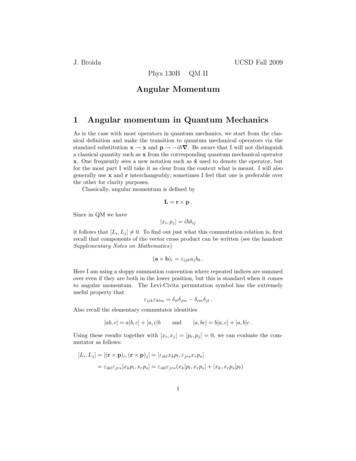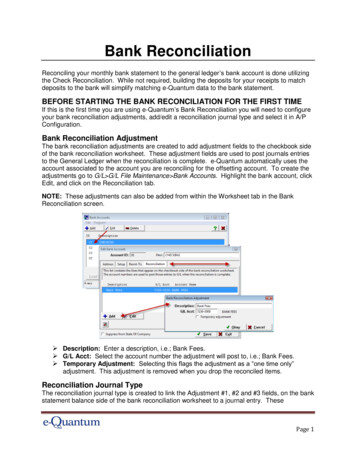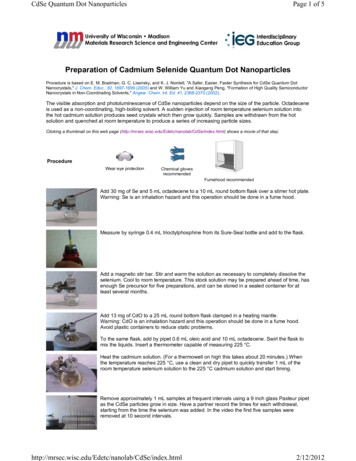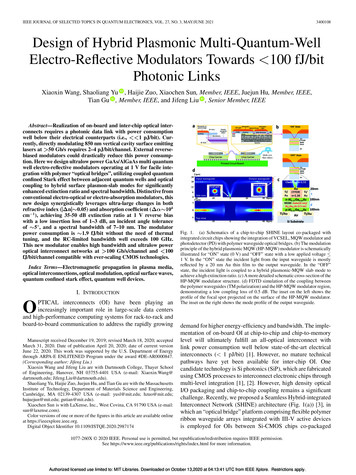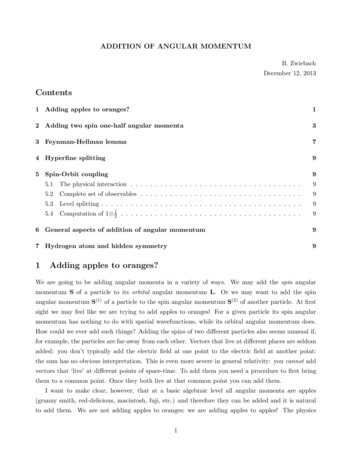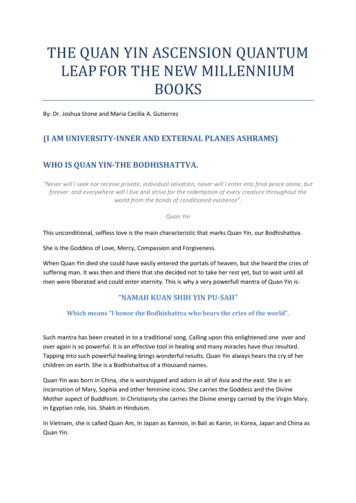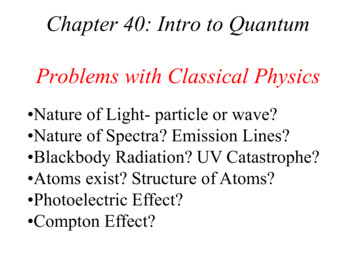
Transcription
Chapter 40: Intro to QuantumProblems with Classical Physics Nature of Light- particle or wave? Nature of Spectra? Emission Lines? Blackbody Radiation? UV Catastrophe? Atoms exist? Structure of Atoms? Photoelectric Effect? Compton Effect?
Black Body Radiation and theDawn of Quantum Mechanicshttps://www.youtube.com/watch?v B7pACq xWyw
Thomas Young 1804Double Slit is VERY IMPORTANT because it is evidenceof waves. Only waves interfere like this.dsin m Copyright 2008 Pearson Education, Inc., publishing as Pearson Addison-Wesley.
REVIEW! Derive Fringe Equations For bright fringesy bright λLm ( m 0 , 1, 2d) For dark fringesy dark λL 1 m ( m 0 , 1, 2d 2 )
Double Slit for Electronsshows Wave Interference!Key to Quantum Theory!
James Clerk Maxwell 1860sLight is an electromagnetic wave.The medium is the Ether.c 1 0 o 3.0 x108 m / sCopyright 2008 Pearson Education, Inc., publishing as Pearson Addison-Wesley.
Heinrich Rudolf Hertz 1857 – 1894 German physicist First to generate anddetect electromagneticwaves in a laboratorysetting in 1887.Section 34.2
The Electromagnetic SpectrumCopyright 2008 Pearson Education, Inc., publishing as Pearson Addison-Wesley.
Maxwell-Boltzmann Distribution: 1877 The observed speeddistribution of gas moleculesin thermal equilibrium isshown at right NV is called the MaxwellBoltzmann speeddistribution function The distribution of speeds inN gas molecules is The probability of finding themolecule in a particularenergy state variesexponentially as the negativeof the energy divided by kBTnV (E ) noe –E /kBTLudwig Boltzmann1844 – 1906 mo NV 4 N 2 kTB 3/2v 2e mv2/ 2 kBT
Temperature Ave KE of each particle Particles have different speeds Gas Particles are in constant RANDOM motion Equipartition of Energy: Average KE ofk 1.38 x 10-23 J/K Boltzmann’s Constanteach particle is: 3/2 kT Pressure is due to momentum transferSpeed ‘Distribution’ atCONSTANT Temperatureis given by theMaxwell Speed Distribution23/ 2kT KE 1/ 2mvrms
Equipartition of Energy Each translational degree of freedomcontributes an equal amount to theenergy of the gas Each degree of freedom contributes½kBT to the energy of a system, wherepossible degrees of freedom are thoseassociated with translation, rotationand vibration of molecules Theory breaks down for black bodyradiation – degrees of freedom getfrozen out.
Kirkoff’s Rules for Spectra: 1859German physicist who developed the spectroscope and the science ofemission spectroscopy with Bunsen.BunsenKirkoff* Rule 1 : A hot and opaque solid, liquid or highly compressed gas emits a continuous spectrum.* Rule 2 : A hot, transparent gas produces an emission spectrum with bright lines.* Rule 3 : If a continuous spectrum passes through a gas at a lower temperature, the transparentcooler gas generates dark absorption lines.Copyright 2008 Pearson Education, Inc., publishing as Pearson Addison-Wesley.
Continuous vs DiscreteThis is a continuous spectrum of colors: all colors are present.This is a discrete spectrum of colors: only a few are present.Copyright 2008 Pearson Education, Inc., publishing as Pearson Addison-Wesley.
Review: Dispersion: Diffraction GratingsHow does dispersion with a grating compare with a prism?Longer wavelength light is bent more with a grating.Shorter wavelength light is bent more with a prism.d sin m Copyright 2008 Pearson Education, Inc., publishing as Pearson Addison-Wesley.
Incandescent Light BulbCopyright 2008 Pearson Education, Inc., publishing as Pearson Addison-Wesley.
Hydrogen SpectraCopyright 2008 Pearson Education, Inc., publishing as Pearson Addison-Wesley.
Helium SpectraCopyright 2008 Pearson Education, Inc., publishing as Pearson Addison-Wesley.
Mercury SpectraCopyright 2008 Pearson Education, Inc., publishing as Pearson Addison-Wesley.
Neon SpectrumCopyright 2008 Pearson Education, Inc., publishing as Pearson Addison-Wesley.
Compare absorption lines in a source with emission lines found in the laboratory!Kirchhoff deduced that elements were present in the atmosphere of the Sunand were absorbing their characteristic wavelengths, producing the absorptionlines in the solar spectrum. He published in 1861 the first atlas of the solarspectrum, obtained with a prism ; however, these wavelengths were not veryprecise: the dispersion of the prism was not linear at all.Copyright 2008 Pearson Education, Inc., publishing as Pearson Addison-Wesley.
Kirkoff’s RulesCopyright 2008 Pearson Education, Inc., publishing as Pearson Addison-Wesley.
Anders Jonas Ångström 1869Ångström measured the wavelengths on thefour visible lines of the hydrogen spectrum,obtained with a diffraction grating, whosedispersion is linear, and replacedKirchhoff's arbitrary scale by thewavelengths, expressed in the metricsystem, using a small unit (10-10 m) withwhich his name was to be associated.Line colorredblue-greenvioletvioletCopyright 2008 Pearson Education, Inc., publishing as Pearson Addison-Wesley.Wavelength6562.852 Å4861.33 Å4340.47 Å4101.74 Å
Balmer Series: 1885Johann Balmer found an empirical equation thatcorrectly predicted the four visible emissionlines of hydrogenJohannes Robert Rydberg generalizedit in 1888 for all transitions:11 1 RH 2 2 λn 2RH is the Rydberg constantRH 1.097 373 2 x 107 m-1n is an integer, n 3, 4, 5, The spectral lines correspond to differentCopyright 2008 Pearson Education, Inc., publishing as Pearson Addison-Wesley.values of nHα is red, λ 656.3 nmHβ is green, λ 486.1 nmHγ is blue, λ 434.1 nmHδ is violet, λ 410.2 nm
All objects radiate energy continuouslyin the form of electromagnetic wavesdue to thermal vibrations of theirmolecules.When an object it heated it willglow first in the infrared, then thevisible. Most solid materials breakdown before they emit UV andhigher frequency EM waves.LongShortCopyright 2008 Pearson Education, Inc., publishing as Pearson Addison-Wesley.Frequency Temperature
Blackbody Radiation A black body is an ideal system thatabsorbs all radiation incident on it The electromagnetic radiation emitted by ablack body is called blackbody radiationCopyright 2008 Pearson Education, Inc., publishing as Pearson Addison-Wesley.
Why this shape? Why the drop?Copyright 2008 Pearson Education, Inc., publishing as Pearson Addison-Wesley.
Stefan’s Law: 1879P e T A4Rate of radiation of a Black Bodyis the rate of energy transfer, in Watts– σ 5.6696 x 10-8 W/m2 . K4– A is the surface area of the object– e is a constant called the emissivityJožef Stefan(1835–1893) e varies from 0 to 1 The emissivity is also equal to the absorptivity– T is the temperature in Kelvins– With his law Stefan determined the temperature of theSun’s surface and he calculated a value of 5430C. Thiswas the first sensible value for the temperature of the Sun.– Boltzmann was his student and derived Stefan’s Law fromThermodynamics in 1884 and extended it to grey bodies.
Blackbody Experiment ResultsThe total power of the radiation emitted from thesurface increases with temperature– Stefan’s law: P AeT4(T must be in kelvin):– P is the power and is the Stefan-Boltzmann constant: 5.670 x10-8 W / m2 . K4 (0 e 1, for a blackbody, e 1)Intensity is Power/Area so: I eT4The peak of the wavelength distribution shifts toshorter wavelengths as the temperature increases– Wien’s displacement lawCopyright 2008 Pearson Education, Inc., publishing as Pearson Addison-Wesley.
Copyright 2008 Pearson Education, Inc., publishing as Pearson Addison-Wesley.
Sun PowerThe radius of our Sun is 6.96 108 m, and itstotal power output is 3.77 1026 W. (a)Assuming that the Sun’s surface emits as a blackbody, calculate its surface temperature. (b) Usingthe result of part (a), find λmax for the Sun.Copyright 2008 Pearson Education, Inc., publishing as Pearson Addison-Wesley.
Sun vs Earth Black Body Emission CurvesSun emits most strongly in the visible, the Earth in the Infrared which is trappedby the Atmosphere and warms the planet– green house effect.Copyright 2008 Pearson Education, Inc., publishing as Pearson Addison-Wesley.
The heating effect of a medium such as glass or the Earth’satmosphere that is transparent to short wavelengths but opaqueto longer wavelengths: Short get in, longer are trapped!
Sun vs Earth Peak WavelengthCopyright 2008 Pearson Education, Inc., publishing as Pearson Addison-Wesley.
QuickCheck 37.2A brass plate at room temperature (300 K) radiates 10 W ofenergy. If its temperature is raised to 600 K, thewavelength of maximum radiated intensityA. Increases.B. Decreases.C. Remains the same.D. Not enough information to tell.Copyright 2008 Pearson Education, Inc., publishing as Pearson Addison-Wesley.Slide 37-31
QuickCheck 37.2A brass plate at room temperature (300 K) radiates 10 W ofenergy. If its temperature is raised to 600 K, thewavelength of maximum radiated intensityA. Increases.B. Decreases.C. Remains the same.D. Not enough information to tell.Copyright 2008 Pearson Education, Inc., publishing as Pearson Addison-Wesley.Slide 37-32
Intensity of Blackbody RadiationStefan’s law:P AeT4Wein’s Law:I P/A T4 The intensity increases withincreasing temperature The amount of radiation emittedincreases with increasingtemperature– The area under the curve The peak wavelength decreaseswith increasing temperature Combining gives the RayleighJeans law:1I λ ,T 4λCopyright 2008 Pearson Education, Inc., publishing as Pearson Addison-Wesley.
Problems with the Wein’s World1I λ ,T 4λ At short wavelengths, therewas a major disagreementbetween the Rayleigh-Jeanslaw and experiment This mismatch becameknown as the ultravioletcatastrophe– You would have infiniteenergy as the wavelengthapproaches zeroCopyright 2008 Pearson Education, Inc., publishing as Pearson Addison-Wesley.
https://www.youtube.com/watch?v FXfrncRey-4
https://www.youtube.com/watch?v 7BXvc9W97iU
Copyright 2008 Pearson Education, Inc., publishing as Pearson Addison-Wesley.
Solves Black Body Mystery. Atomic Energy is quantized.It comes in chunks of Planck’s constant, h.E nhf , n 0,1,2,3,.h 6.626 x10 34 Js2πhc 2I λ,T 5 hc λk Tλ e B 1
Max Planck: Father of Quantum Introduced the conceptof “quantum ofaction” in 1900 tosolve the black bodymystery In 1918 he wasawarded the NobelPrize for the discoveryof the quantized natureof energy
Strings are QuantizedThe possible frequencies and energy states of a wave ona string are quantized.vf n2l
Energy is Quantized An energy-level diagramshows the quantized energylevels and allowedtransitions Energy is on the vertical axis Horizontal lines representthe allowed energy levels The double-headed arrowsindicate allowed transitions
Equipartition of Energy Each translational degree of freedomcontributes an equal amount to theenergy of the gas Each degree of freedom contributes½kBT to the energy of a system, wherepossible degrees of freedom are thoseassociated with translation, rotationand vibration of molecules Theory breaks down for black bodyradiation – degrees of freedom getfrozen out.
Copyright 2008 Pearson Education, Inc., publishing as Pearson Addison-Wesley.
Planck’s Two Assumptions The energy of an oscillator canhave only certain discretevalues En nhƒ, n interger– This says the energy isquantized– Each discrete energy valuecorresponds to a differentquantum state The oscillators emit or absorbenergy when making atransition from one quantumstate to another– The entire energydifference between theinitial and final states in thetransition is emitted orabsorbed as a singlequantum of radiation2πhc 2I λ,T 5 hc λk Tλ e B 1
The Turn Around in Planck’sModel The average energy of a wave is the averageenergy difference between levels of the oscillator,weighted according to the probability of the wavebeing emitted This weighting is described by the Boltzmanndistribution law and gives the probability of a statebeing occupied as being proportional toe E kBT
Planck had seen the turn over before:Maxwell-Boltzmann Distribution: 1877 The observed speeddistribution of gas moleculesin thermal equilibrium isshown at right NV is called the MaxwellBoltzmann speeddistribution function The distribution of speeds inN gas molecules is The probability of finding themolecule in a particularenergy state variesexponentially as the negativeof the energy divided by kBTLudwig Boltzmann1844 – 1906 mo NV 4 N 2 kTB nV (E ) noe –E /kBTCopyright 2008 Pearson Education, Inc., publishing as Pearson Addison-Wesley.3/2v 2e mv2/ 2 kBT
Planck’s WavelengthDistribution Function Planck generated a theoretical expressionfor the wavelength distribution2πhc 2I λ,T 5 hc λk Tλ e B 1 – h 6.626 x 10-34 J.s– h is a fundamental constant of nature
Solves Black Body Mystery. Atomic Energy is quantized.It comes in chunks of Planck’s constant, h.E nhf , n 0,1,2,3,.h 6.626 x10 34 Js2πhc 2I λ,T 5 hc λk Tλ e B 1 Copyright 2008 Pearson Education, Inc., publishing as Pearson Addison-Wesley.
Max Planck: Fatherof Quantum In 1900 Planck developed a theory ofblackbody radiation that leads to anequation for the intensity of theradiation which is in completeagreement with experimentalobservations. From his radiation equations Stefan’sLaw is Derived!! Introduced the concept of “quantum ofaction” in 1900 In 1918 he was awarded the NobelPrize for the discovery of thequantized nature of energyE nhf , n 0,1,2,3,.h 6.626 x10 34 Js2πhc 2I λ,T 5 hc λk Tλ e B 1
https://www.youtube.com/watch?v i1TVZIBj7UA&
Intensity of Blackbody RadiationP40.61The total power per unit area radiated bya black body at a temperature T is the areaunder the I(λ, T)-versus-λ curve, asshown in Figure 40.3. (a) Show that thispower per unit area is 0I λ, T dλ T 4where I(λ, T) is given by Planck’sradiation law and σ is a constantindependent of T.This result is Stefan’s law.To carry out the integration, you should makethe change of variable x hc/λkT and use thefact that 0x 3 dx 4 xe 1 152πhc 2I λ,T 5 hc λk Tλ e B 1
Particle Wave DualityWhat is a particle? What is a wave?
The Photoelectric Effect In 1886 Hertz noticed, in thecourse of his investigations, that anegatively charged electroscopecould be discharged by shiningultraviolet light on it. In 1899, Thomson showed that theemitted charges were electrons. Around 1900, Phillip Lenard builtan apparatus which produced anelectric current when ultravioletlight was shining on the cathode. This phenomenon is called thephotoelectric effect.
The PROBLEM with thePhotoelectric EffectThe Problem with Waves:Increasing the intensity of a low frequencylight beam doesn’t eject electrons. Thisdidn’t agree with wave picture of lightwhich predicts that the energy of wavesadd so that if you increase the intensity oflow frequency light (bright red light)eventually electrons would be ejected –but they don’t! There is a cut offfrequency, below which no electrons willbe ejected no matter how bright the beam!Also there is no time delay in the ejectionof electrons as the waves build up!
The Photoelectric EffectProof that Light is a ParticleThe Problem with Waves:Increasing the intensity of a low frequencylight beam doesn’t eject electrons. Thisdidn’t agree with wave picture of lightwhich predicts that the energy of wavesadd so that if you increase the intensity oflow frequency light (bright red light)eventually electrons would be ejected –but they don’t! There is a cut offfrequency, below which no electrons willbe ejected no matter how bright the beam!Also there is no time delay in the ejectionof electrons as the waves build up!
https://www.youtube.com/watch?v v-1zjdUTu0o
Characteristics of thePhotoelectric Effect1. The current I is directly proportional to the light intensity.2. Photoelectrons are emitted only if the light frequency fexceeds a threshold frequency f0.3. The value of the threshold frequency f0 depends on thetype of metal from which the cathode is made.4. If the potential difference ΔV is positive, the current doesnot change as ΔV is increased. If ΔV is made negative, thecurrent decreases until, at ΔV Vstop the current reacheszero. The value of Vstop is called the stopping potential.5. The value of Vstop is the same for both weak light andintense light. A more intense light causes a larger current,but in both cases the current ceases when ΔV Vstop.
ThePhotoelectricEffect
toelectr
Photoelectric Effect Problem 1 Dependence of photoelectron kinetic energy onlight intensity– Classical Prediction Electrons should absorb energy continually from theelectromagnetic waves As the light intensity incident on the metal is increased, theelectrons should be ejected with more kinetic energy– Experimental Result The maximum kinetic energy is independent of light intensity The maximum kinetic energy is proportional to the stoppingpotential (DVs)
Photoelectric Effect Problem 2 Time interval between incidence of light andejection of photoelectrons– Classical Prediction At low light intensities, a measurable time interval should passbetween the instant the light is turned on and the time anelectron is ejected from the metal This time interval is required for the electron to absorb theincident radiation before it acquires enough energy to escapefrom the metal– Experimental Result Electrons are emitted almost instantaneously, even at very lowlight intensities
Photoelectric Effect Problem 3 Dependence of ejection of electrons on lightfrequency– Classical Prediction Electrons should be ejected at any frequency as long as the lightintensity is high enough– Experimental Result No electrons are emitted if the incident light falls below somecutoff frequency, ƒc The cutoff frequency is characteristic of the material beingilluminated No electrons are ejected below the cutoff frequency regardlessof intensity
Photoelectric Effect Problem 4 Dependence of photoelectron kinetic energy onlight frequency– Classical Prediction There should be no relationship between the frequency of thelight and the electric kinetic energy The kinetic energy should be related to the intensity of the light– Experimental Result The maximum kinetic energy of the photoelectrons increaseswith increasing light frequency
Einstein’s Postulates: Light QuantaEinstein framed three postulates about light quanta andtheir interaction with matter:1. Light of frequency f consists of discrete quanta, eachof energy E hf, where h is Planck’s constanth 6.63 10 34 J s. Each photon travels at thespeed of light c 3.00 108 m/s.2. Light quanta are emitted or absorbed on an all-ornothing basis. A substance can emit 1 or 2 or 3quanta, but not 1.5. Similarly, an electron in a metalcan absorb only an integer number of quanta.3. A light quantum, when absorbed by a metal, deliversits entire energy to one electron.
E hfLight is quantized in chunks of Planck’s constant.Electrons will not be ejected in the Photoelectric Effect unless everyphoton has the right energy. One photon is completely absorbed byeach electron ejected from the metal. As you increase the intensity ofthe beam, more electrons are ejected, but their energy stays the same.Photons
Einstein’s Explanation of thePhotoelectric EffectAn electron that has just absorbed a quantum of lightenergy has Eelec hf. (The electron’s thermal energy atroom temperature is so much less than that we can neglectit.) This electron can escape from the metal, becoming aphotoelectron, ifIn other words, there is a threshold frequencyfor the ejection of photoelectrons because each lightquantum delivers all of its energy to one electron.
Einstein’s Explanation of thePhotoelectric Effect A more intense light delivers a larger number of lightquanta to the surface. These quanta eject a larger numberof photoelectrons and cause a larger current. There is a distribution of kinetic energies, becausedifferent photoelectrons require different amounts ofenergy to escape, but the maximum kinetic energy isThe stopping potential Vstop is directly proportional to Kmax.Einstein’s theory predicts that the stopping potential isrelated to the light frequency by
EX 39.2 The energy of a light quantum
hf KEmax E0PhotonEnergyMax KE ofejected electronWork to eject(Work Function)or Binding Energy
Cutoff Frequency The lines show the linearrelationship between K and ƒThe slope of each line is h The x-intercept is the cutofffrequency. This is thefrequency below which nophotoelectrons are emitted The cutoff frequency is relatedto the work function throughƒc φ / h The cutoff frequencycorresponds to a cutoffwavelengthc hcλc ƒc φ
Work Function
QuickCheck 38.3What happens to this graph of thephotoelectric current if the intensity ofthe light is reduced to 50%?A.B.C.D. None of these.Slide 38-44
QuickCheck 38.3What happens to this graph of thephotoelectric current if the intensity ofthe light is reduced to 50%?A.B.C.D. None of these.Stopping potentialdoesn’t change.Slide 38-45
QuickCheck 38.4What happens to this graph ofthe photoelectric current if thecathode’s work function isslightly increased?A.B.C.D. None of these.Slide 38-46
QuickCheck 38.4What happens to this graph ofthe photoelectric current if thecathode’s work function isslightly increased?Number of photoelectrons unchangedA.D. None of these.B.Electrons emergeslower, so stoppingpotential reduced.C.Slide 38-47
QuickCheck 38.5What happens to this graph of thephotoelectric current if the cathode’swork function is slightly increased?A.B.C.D. None of these.Slide 38-50
QuickCheck 38.5What happens to this graph of thephotoelectric current if the cathode’swork function is slightly increased?A.D. None of these.B.C.Threshold shifts toshorter wavelength.Slide 38-51
QuickCheck 38.6What happens to this graph of thephotoelectric current if the cathode’swork function is larger than thephoton energy?A.B.C.D. None of these.Slide 38-52
QuickCheck 38.6What happens to this graph of thephotoelectric current if the cathode’swork function is larger than thephoton energy?A.D. None of these.B.C.Below threshold if Ephoton E0Slide 38-53
Maximum photoelectron speed
The Photoelectric EffectWhat is the maximum velocity of electrons ejected froma material by 80nm photons, if they are bound to thematerial by 4.73eV? Ignore relatavistic effects.K Max hf BE hc BE 3486.63 10J s3.00 10m s 80.0 10 9 m 1.60 10 19 J 4.73 eV 1eV 1.7295 10 18 J1 22KE 2 1.729 10 J K mv v 312m 9.11 10 kg 18(SR: K ( 1)mc2 )12 1.95 106 m s
https://www.youtube.com/watch?v NoFufZNuKYQ
https://www.youtube.com/watch?v f61eMq4Wg4w
The phenomenon in which an X-ray photon is scattered from anelectron, the scattered photon having a smaller frequency than theincident photon is called The Compton Effect.E mcDivide:E pcE hf p p mv2h hc pc
Compton Effect, ClassicalPredictions According to theclassical theory, EMwaves incident onelectrons should:– have radiation pressurethat should cause theelectrons to accelerate– set the electronsoscillating– Because of Doppler shift,there should be a range ofscattered frequencies
Compton Effect, Observations Compton’sexperiments showedthat, at any givenangle, only onefrequency of radiationis observed – nodistribution due toDoppler shifts.
Compton Effect, Explianed The results could be explained by treatingthe photons as point-like particles havingenergy hƒ Assume the energy and momentum of theisolated system of the colliding photonelectron are conserved This scattering phenomena is known as theCompton effect
The photon transfers momentum, acts like a particle.pincident pscattered pelectronThe graphs show thescattered x-ray forvarious anglesThe shifted peak, λ’ iscaused by the scatteringof free electrons givenby the Compton ShiftEquation:hλ' λo 1 cos θ mec
Arthur Holly Compton 1892 - 1962 Director of the lab atthe University ofChicago Discovered theCompton Effect, 1923 Shared the NobelPrize in 1927
Compton WavelengthThe Compton wavelength of a particle is equivalent to the wavelength of aphoton whose energy is the same as the rest mass of the particle.The Compton wavelength of the electron is:h 2.43 x10 12 mmecCompton wavelength is kinda the quantum mechanical cutoff - the lengthscale below which relativistic quantum mechanics can simply not be ignored infavor of classical quantum hysical-meaningof-Compton-wavelength-frac-h-m oc
,The incident X-ray photonhas an energy of 3.98 keVand is scattered by anangle of 140.0 degrees.a) What is the wavelength ofincident X-ray?b) What is the wavelength ofthe scattered X-ray?c) What is the energy of thescattered X-ray?d) What is the kinetic energyof the recoil electron?e) What is the de Brogliewavelength of the recoilelectron?c 2.998x108 m / sme 9.109 x10 31 kgh 6.626 x10 34 Js1.602 x10 19 J / eV
If photons can be particles, thenwhy can’t electrons be waves?E hf hp cc deBroglie Wavelength:h e pElectrons areSTANDINGWAVES inatomic orbitals.
Electrons exist in quantized orbitals with energies given bymultiples of Planck’s constant. Light is emitted or absorbed whenan electron makes a transition between energy levels. The energy ofthe photon is equal to the difference in the energy levels:E nhf , n 0,1,2,3,.h 6.626 x10 34JsE Ei E f hf
Light Absorption & EmissionE Ei E f hf
Classical Physics at the LimitWHY IS MATTER (ATOMS)STABLE?
2 rn n 1924: de Broglie WavesExplains Bohr’s postulate of angularmomentum quantization:2 rn n hh2 rn n npme vhme vrn n2 hL me vrn n2 (n 1, 2,3,.)h p
1924: de Broglie WavesElectrons are STANDING WAVES in atomic orbitals.h p2 rn n
De Broglie Wavelengthh mv 34h 6.626 x10J s
Electron De Broglie Wavelengthfor electron v 0.1c h / mv 346.626 x10 J s 317(9.1x10 kg )(3x10 m / s ) 2.4 x10 m 11
Lynda’s De Broglie Wavelength 346.626 x10 J s (75kg )2m / s 4.4 x10 m 36Too small to notice or to interact with anything!
What is the deBroglie wavelength of an electron ejected by 420 nmphotons from a material with a binding energy of 2.71eV?
Quick Quiz 40.4Suppose classicalphysicists had come upwith the idea of predictingthe appearance of a plot ofKmax versus f, as in thisfigure. Draw a graph ofwhat their expected plotwould look like, based onthe wave model for light.
Quick Quiz 40.4Answer: Classical physics predicts that light of sufficientintensity causes emission of photoelectrons, independent offrequency and without a cutoff frequency. Also, the greaterthe intensity, the larger the maximum kinetic energy of theelectrons, with some time delay in emission at lowintensities. Thus the classical expectation (which did notmatch experiment) yields a graph that looks like this:
Quick Quiz 40.2While standing outdoors one evening, you are exposed tothe following four types of electromagnetic radiation: yellowlight from a sodium street lamp, radio waves from an AMradio station, radio waves from an FM radio station, andmicrowaves from an antenna of a communications system.Rank these types of waves in terms of increasing photonenergy, lowest first.(a) sodium light, AM, FM, microwave(b) AM, FM, sodium light, microwave(c) AM, FM, microwave, sodium light(d) microwave, sodium light, AM, FM
Quick Quiz 40.2Answer: (c). The order of photon energy will be the same asthe order of frequency. See Figure 34.12 for a pictorialrepresentation of electromagnetic radiation in order offrequency.
Quick Quiz 40.5Note that for any given scattering angle θ, Equation 40.11(seen below) gives the same value for the Compton shift forany wavelength. Keeping this in mind, for which of thefollowing types of radiation is the fractional shift inwavelength at a given scattering angle the largest?(a) radio waves(b) microwaves(c) visible light(d) x-rays
Quick Quiz 40.5Answer: (d). The shift Δλ is independent of λ. Thus, thelargest fractional shift will correspond to the smallestwavelength.
Quick Quiz 40.6An electron and a proton both moving at nonrelativisticspeeds have the same de Broglie wavelength. Which of thefollowing are also the same for the two particles?(a) speed(b) kinetic energy(c) momentum(d) frequency
Quick Quiz 40.6Answer: (c). According to Equation 40.15, two particleswith the same de Broglie wavelength will have the samemomentum p mv. If the electron and proton have the samemomentum, they cannot have the same speed (a) because ofthe difference in their masses. For the same reason, becauseK p2/2m, they cannot have the same kinetic energy (b).Because the particles have different kinetic energies,Equation 40.16 tells us that the particles do not have thesame frequency (d).
Quick Quiz 40.7We have discussed two wavelengths associated with theelectron—the Compton wavelength and the de Brogliewavelength. Which is an actual physical wavelengthassociated with the electron?(a) the Compton wavelength(b) the de Broglie wavelength(c) both wavelengths(d) neither wavelength
Quick Quiz 40.7Answer: (b). The Compton wavelength (Section 40.3) is acombination of constants and has no relation to the motionof the electron. The de Broglie wavelength (Eq. 40.15) isassociated with the motion of the electron through itsmomentum.
Quick Quiz 40.9As an analogy to wave packets, consider a “runner packet”that occurs at the start of a footrace of length L. As
Stefan’s Law: 1879 Rate of radiation of a Black Body is the rate of energy transfer, in Watts – σ 5.6696 x 10-8 W/m2 .K4 – A is the surface area of the object – e is a constant called the emissivity e varies from 0 to 1 The emissivity is also equal to the absorptivity – T is the temperature in Kelvin
